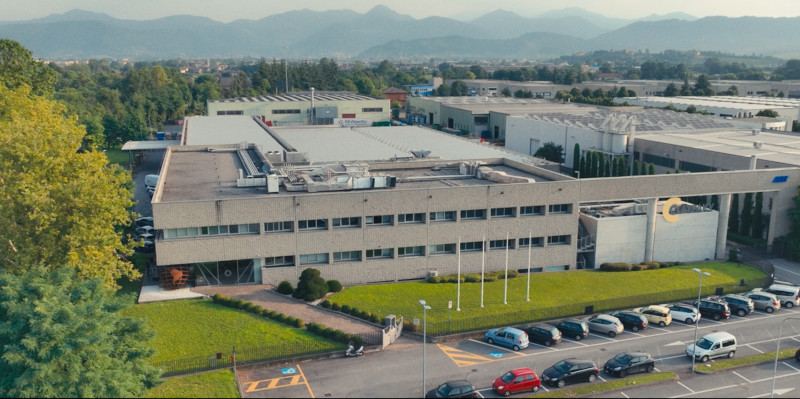Sustainability
Striving for excellence, our strategy continuously evolves, aiming to drastically reduce greenhouse gas (GHG) emissions and combat climate change. Believing that what is not measured cannot be improved, we took the first step of understanding, quantifying, and analyzing our current carbon footprint using the ISO 14064-1:2018 norm and achieving certification via a third-party auditing process. We successfully completed this part of the initiative and are proud to have become the first company in the entertainment lighting industry to receive certification in the carbon inventory management system for three consecutive years.

Our commitment
The ISO 14064 certification, received in November 2023, calculates the impact on climate change at the organizational level for the year 2022.
This study, performed with the support of Spinlife, a spin-off of the University of Padova, has been carried out with a “cradle to grave” approach analyzing all direct and indirect emissions. This organizational carbon footprint assessment allows us to understand where the environmental hot spots are and to define concrete actions to reduce our impact on climate change. Armed with these data, we updated our carbon management plan established in 2022, outlining a robust GHG reduction strategy.
These steps demonstrate our reputation for innovation and trendsetting not only in the product and technology field but also beyond by taking the company and its entire operations into consideration towards our sustainability goals.

Our contribution
We are already in action. Several projects to reduce the environmental impact of our business activities have already been successfully implemented.
Through these initiatives, we are not just reducing our carbon footprint, but actively contributing to the global fight against climate change, solidifying our role in a sustainable future.

Ultra-High Performance Lamp
Ultra-High Performance Lamp
The Ultra-High Performance Lamp sets a new standard for sustainable lighting. With its long lifespan (up to 6,000 hrs), low mercury content, and advanced dimming technology, it’s built to reduce waste and energy consumption. Made from fully recyclable materials, the lamp offers an eco-conscious solution that reduces environmental impact without sacrificing performance.

Plastic-Free Packaging
Plastic-Free Packaging
We’re transitioning from non-recyclable polystyrene foams to eco-friendly packaging to reduce our environmental footprint, while still ensuring safe product transportation.

Kanban Control System
Kanban Control System
We’ve implemented the Kanban control system in our manufacturing process to boost efficiency and minimize waste, ensuring a smarter, more sustainable production flow.

Solar Panels
Solar Panels
We’ve succesfully installed photovoltaic panels on the roof of our production plant with an estimated production of 400 MWh, which will bring us nearly to full independence from the grid.

Smart Heat Management System
Smart Heat Management System
We’ve introduced a smart heat management system to optimize energy use and reduce our methane consumption during the colder months.

100% Renewable Energy
100% Renewable Energy
As part of our CP Green initiative, we’re proud to power all operations at our Headquarters with 100% electricity from certified renewable sources. It’s all about creating the right supply chain to shape our vision.

Electric Car Fleet
Electric Car Fleet
Our internal car fleet is now 100% electric, driving us toward a more sustainable future.

Energy-efficient Laser Cutting Machine
Energy-efficient Laser Cutting Machine
We’ve upgraded to new, energy-efficient laser cutting machine, boosting our production capabilities while reducing energy consumption for a more sustainable operation.

LED Lighting
LED Lighting
We have replaced all interior lighting with energy-efficient LED solutions, significantly reducing energy consumption and enhancing our sustainability efforts.

Innovation Product Roadmap
Innovation Product Roadmap
We’re driving innovation with a roadmap focused on developing low-energy-consuming products and components, paving the way for a more sustainable future.

Going Paperless
Going Paperless
We’ve transitioned to a paperless operation in both our production process and at trade fairs, streamlining workflows and reducing our environmental impact.

Advanced Data Management
Advanced Data Management
We’ve implemented a cutting-edge data collection and management system, enabling us to track and enhance our environmental performance with greater precision and reliability.

Offsetting Airplane Travels
Offsetting Airplane Travels
We’ve committed to compensating the carbon emissions from our air travel by investing in environmental projects that help neutralize the impact of our flights balancing out the negative impact on the environment by supporting efforts that contribute to sustainability.
Download section
CP Green leaflet
2025
ISO 14064-1
2025
Q&As
-
Climate change is defined as the change in the typical weather of a certain geographical area. This change might cause an alteration in the usual temperature of a place or in the regular amount of precipitation. When greenhouse gases (GHG), such as CO2, CH4, N2O, fluorinated gases, etc., are trapped in the atmosphere, they cause an increase in the globe’s temperature resulting in climate change.
Nowadays, climate change is a worldwide phenomenon affecting every geographical area and causing financial burdens to all countries due to its negative effects. One of the most common impacts is the increase in sea level, which leads to coastal erosion and flooding. Other adverse effects of climate change are the migration of species to new places and increase in the extinction rate, and the weakening of sectors depending on precipitation levels and temperature such as tourism, agriculture, and energy. -
The Sustainable Development Goals (SDGs) compose a universal action plan aiming at achieving global sustainable development. These objectives were adopted in September 2015 and are planned to be reached by 2030. There are 17 integrated SDGs affecting each aspect of our way of living and aimed at ensuring improvements from a social, economic, and environmental aspect. Especially, SDG 12, Responsible Consumption and Production, aims to ensure sustainable consumption and production patterns and, it sets targets to decrease the ecological footprint of our way to manufacture and consume goods and resources.
-
The removal/reduction of carbon gases released into the atmosphere is referred to as decarbonization. Companies’ decarbonization efforts are associated with the calculation of their carbon footprints, defined as the total quantity of greenhouse gases emitted by that company. Hence, decarbonization entails removing and/or reducing their carbon footprint by compensating or decreasing the GHG emissions.
-
Compensation is a widespread application between companies that desire to reach carbon neutrality. This concept entails reducing the carbon footprint of a firm via buying credits generated by projects aimed at decreasing emissions in another part of the world. Once a company’s carbon footprint has been calculated, some or all of that amount can be neutralized by compensation. This practice supports companies’ decarbonization efforts.
-
ISO is an organization developing international standards. The “ISO 14064-1:2018 Greenhouse gases-Part 1: Specification with guidance at the organization level for quantification and reporting of greenhouse gas emissions and removals” is a standard used for measurement of GHG emissions emitted at the organizational level. This standard is adopted for the calculation of the carbon footprint of an organization in a reliable way. Compliance with such a certification allows obtaining the related certification via third-party auditing.